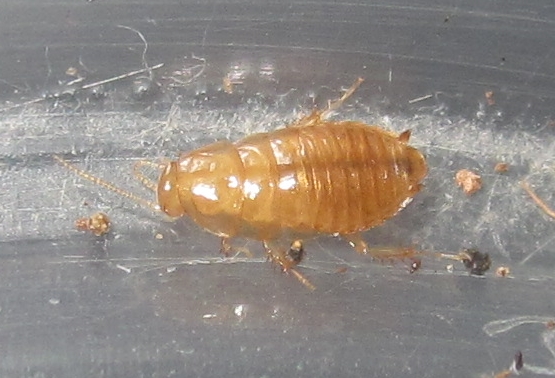Now, this breeder was in Scotland, and didn't want to ship outside the country, only handing them off to one breeder from the UK who made the trip there to meet up in person. I've been painstakingly tracking the growth and spread of this species in the EU hobby for YEARS now, and FINALLY, after much anticipation, I have a culture of 15 small nymphs thanks to György Fiam. 😁
Before we get to the setup, some neat facts about this species. It's a Blaberid, currently not assigned to any subfamily. The nymphs are straw colored when young, turning orange in later instars, and then finally metallic green with a bluish tinge at maturity, with four orange spots on the tegmina. All life stages burrow through adults are more surface active, nymphs can't climb but adults can climb and fly. Overall husbandry seems similar to Panchlora and certain Pycnoscelus spp..
I've got mine set up in a moderately ventilated container with an inch of coconut fiber substrate, which I'm keeping humid. The temperature is about 75-80F°, and I'm feeding them dog food and fruits.
Here are some pictures of the small nymphs:
They may not look like much now, but believe you me, the adults are absolutely stunning, I am so happy to finally have this species and hopefully be able to introduce them to the US hobby! 😁
Well, that does it for this post, thanks for reading, I hope everyone enjoyed, and I'll see you all next time! 😉




I will say I find the adults of these (as opposed to Eucorydia) visually satisfactory (maybe I'm just fastidiously overapplying graphic design principles, though.)
ReplyDeleteThese do have a pretty unique adult shape compared to other roaches in the hobby. From a taxonomic standpoint they're interesting as well, perhaps the only Blaberid roach in culture that isn't yet assigned to a specific subfamily.
DeleteUpdate: discovered some individuals have abdomens that dorsally protrude beyond wings (and [more relevantly] have whitish markings on the exposed part). I do not like that.
DeleteI dipped out of invertebrate keeping in late 2022 for personal reasons, but over the last year and a bit I would sometimes think to myself, "I never did get those Eustegasta for Invertebrate Dude..."
ReplyDeleteNow I'm looking around again, this blog entry makes me cringe at myself, but I'm relieved and glad that you finally got some. Eager to see any updates and photos you have in future. I'm back to a state where I want to get these myself... sometime. Might have to wait until better weather, and see if our mutual Scottish contact still has some.
(Although, I understood the race was on against strict new wildlife import laws in the US? Did that come to pass?)
Hey no worries, I got them eventually, and through an easier to work with source anyways (rather than them going through multiple hands before getting here). 😄 Hopefully you can get some for yourself as well, even if you aren't into keeping inverts as much as you used to, these would be a worthy exception. :)
DeleteIDK about that, haven't heard of any new strict import laws, and that sounds more like something to do with actual legal importation, rather than the BBing everyone does.
How much you expect these to be sold
DeleteThese are really gorgeous and amazing , can’t wait to buy these metallic fellows from you.
ReplyDeleteYeah, I just can't wait to finally see some adults in person! Looks like I've got some presubs already. 😁
DeleteAs for pricing, not sure, I'm thinking $100-150 per 8-10 nymphs, it's gonna depend on just how difficult they are to breed. But definitely nowhere near what magnifica or some Eucorydia are selling for.
Presubs yay! Make the babies LoL
ReplyDeleteThanks, hoping they'll mature soon and breed well for me!
Delete